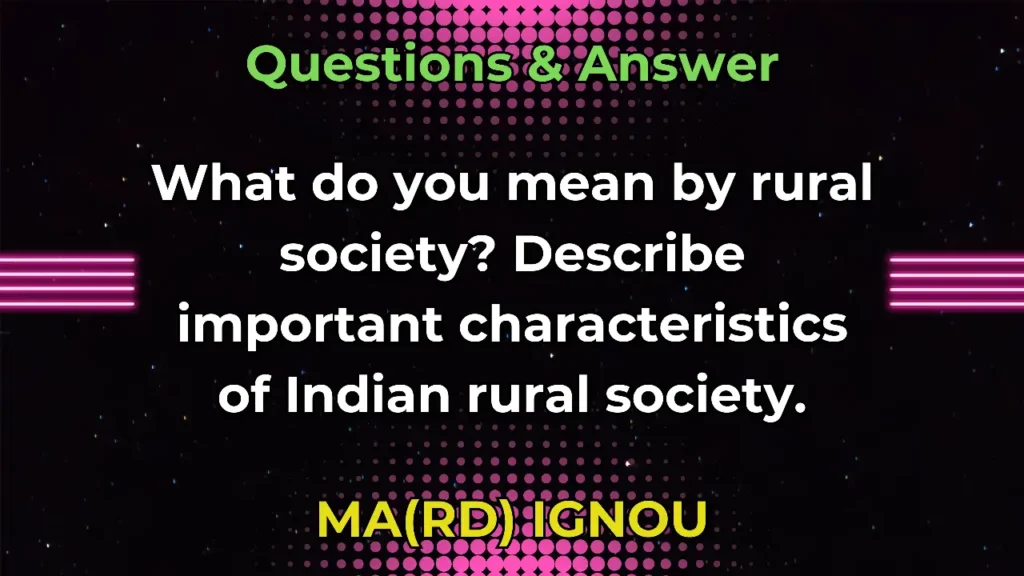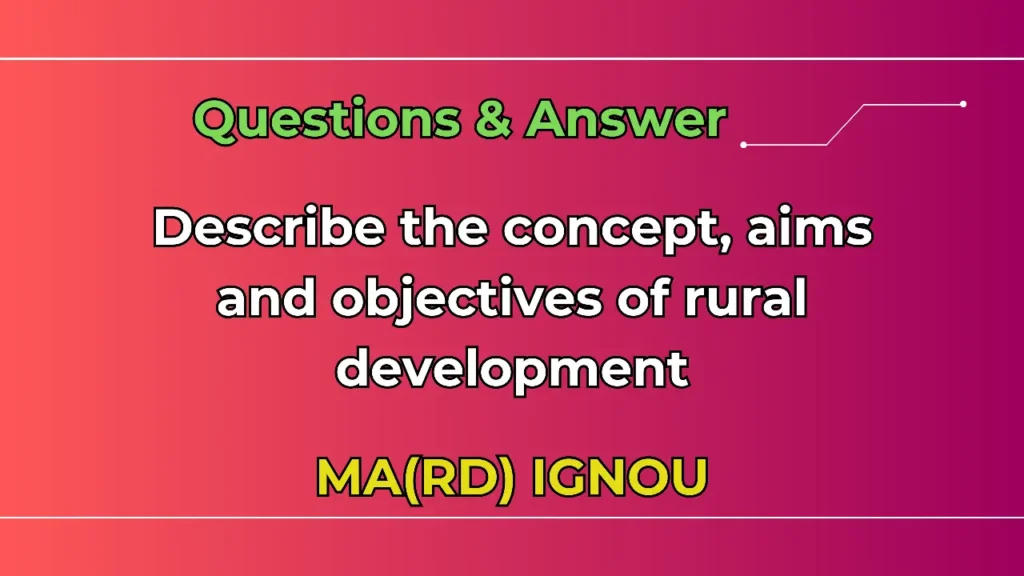What do you mean by rural society? Describe important characteristics of Indian rural society.
IGNOU Assignment Question 2023-24 Session
Rural Development: Indian Context
(This Answer Aprox 930 Words)
Understanding Rural Society
Rural society refers to the social structure, cultural norms, and economic practices characteristic of areas with low population density and vast open spaces, typically centered around agriculture and traditional ways of life. In rural areas, life tends to be more community-focused, with strong ties to family, tradition, and the land.
Rural societies differ significantly from urban societies in terms of occupation, social structure, and cultural practices. They are often seen as more traditional, with slower social change compared to urban areas. The economy of rural societies is usually agrarian, with farming and other forms of primary production as the backbone.
Characteristics of Indian Rural Society
India is predominantly rural, with over 65% of its population residing in villages. Indian rural society is unique in its diversity, with vast differences in culture, tradition, and lifestyle across different regions. Despite these differences, there are several common characteristics that define Indian rural society.
1. Agrarian Economy
Agriculture is the primary occupation in Indian rural society. Most rural families depend on farming, animal husbandry, and related activities for their livelihood. Agriculture in India is often characterized by small-scale subsistence farming, though commercial farming has also made inroads in certain regions. The reliance on monsoon rains and traditional farming methods still plays a significant role in Indian agriculture, which can make rural economies vulnerable to environmental changes.
2. Social Stratification
Indian rural society is deeply rooted in the caste system, which plays a significant role in determining social hierarchy, occupation, and social interactions. Although the influence of the caste system has diminished over time due to legal reforms and social changes, it still remains an important factor in rural areas. The traditional caste-based division of labor has a lingering impact on the socio-economic dynamics of villages, affecting access to resources, education, and employment opportunities.
3. Joint Family System
The joint family system is a common feature of Indian rural society. In a joint family, several generations live under one roof, sharing resources and responsibilities. The head of the family, usually the eldest male, makes key decisions, and the family operates as a single economic unit. This system fosters a sense of unity, cooperation, and collective responsibility among family members. However, with the influence of urbanization and modernization, the joint family system is slowly giving way to nuclear families.
4. Community Life
Community life in rural India is characterized by close-knit relationships and a strong sense of belonging. Villagers often participate in each other’s social, religious, and economic activities. Festivals, marriages, and other social functions are celebrated with the participation of the entire community. This collective way of life fosters solidarity, mutual aid, and a sense of security among villagers.
5. Traditionalism and Conservatism
Indian rural society is generally more traditional and conservative compared to urban areas. Cultural practices, customs, and rituals are deeply rooted and are often followed with great reverence. Changes in social norms and behaviors occur slowly, and there is often resistance to new ideas that challenge established traditions. This conservatism is reflected in various aspects of life, including marriage practices, gender roles, and social mobility.
6. Limited Access to Education and Healthcare
Access to education and healthcare in rural India is limited compared to urban areas. Although there have been significant improvements in recent decades, rural areas still face challenges such as inadequate infrastructure, shortage of trained professionals, and limited awareness. The literacy rate in rural India is lower than in urban areas, and many children still drop out of school due to economic constraints or the need to help with household chores or farming. Similarly, healthcare facilities in rural areas are often underdeveloped, with limited access to hospitals, clinics, and trained medical staff.
7. Poverty and Unemployment
Poverty is a significant issue in Indian rural society. A large proportion of the rural population lives below the poverty line, with limited access to basic amenities such as clean water, sanitation, and electricity. Unemployment and underemployment are common problems, with many villagers engaged in low-paying, unskilled jobs. Seasonal unemployment is also prevalent, especially in agriculture, where work is dependent on the sowing and harvesting seasons.
8. Dependence on Monsoons
Agriculture in rural India is heavily dependent on monsoons. The monsoon season determines the success or failure of crops, and a good monsoon can mean prosperity, while a poor monsoon can lead to drought, crop failure, and severe economic distress. This dependency makes rural economies highly vulnerable to climate variability and environmental changes, contributing to the cycle of poverty and indebtedness among farmers.
9. Role of Panchayati Raj Institutions
The Panchayati Raj system is the foundation of local governance in Indian rural society. These institutions are responsible for the administration of villages and the implementation of development programs. The Panchayats play a crucial role in decision-making, conflict resolution, and the execution of welfare schemes. They also provide a platform for villagers to participate in the governance process and voice their concerns.
10. Gender Inequality
Gender inequality is a persistent issue in Indian rural society. Women in rural areas often face discrimination in various aspects of life, including education, employment, and decision-making. Although women play a significant role in agriculture and household management, their contributions are often undervalued, and they have limited access to resources and opportunities. Early marriage, dowry practices, and restrictions on mobility are common challenges faced by rural women.
11. Cultural Diversity
Indian rural society is culturally diverse, with each region having its own distinct customs, traditions, language, and dialect. This diversity is reflected in the various festivals, folk arts, music, and dance forms practiced in different parts of the country. Despite the differences, there is a strong sense of unity in diversity, with villagers coming together to celebrate festivals and participate in cultural events.
12. Slow Pace of Change
Social change in rural India is generally slow, with traditional practices and beliefs persisting over time. Factors such as education, exposure to urban lifestyles, and government interventions have brought about some changes, but the pace of change remains gradual. The introduction of technology, modernization of agriculture, and increasing migration to urban areas are gradually transforming rural society, but the transition is slow and uneven.
Conclusion
Indian rural society is a complex and multifaceted entity, deeply rooted in tradition yet slowly evolving in response to modern influences. The characteristics of rural society, such as its agrarian economy, social stratification, joint family system, and strong community ties, have shaped the lives of millions of villagers across the country. While rural areas continue to face challenges such as poverty, unemployment, and limited access to education and healthcare, they also hold the potential for growth and development through improved governance, infrastructure, and social reforms.
Understanding the dynamics of Indian rural society is crucial for addressing the issues faced by the rural population and for implementing effective policies and programs aimed at rural development. The future of Indian rural society lies in balancing tradition with modernity, preserving cultural heritage while embracing progress, and ensuring that the benefits of development reach even the most remote corners of the country.
Click Here for More IGNOU Question & Answer
Download IGNOU Assignment Question MA(RD)
What do you mean by rural society What do you mean by rural society What do you mean by rural society What do you mean by rural society What do you mean by rural society What do you mean by rural society What do you mean by rural society What do you mean by rural society What do you mean by rural society What do you mean by rural society What do you mean by rural society What do you mean by rural society What do you mean by rural society What do you mean by rural society What do you mean by rural society


